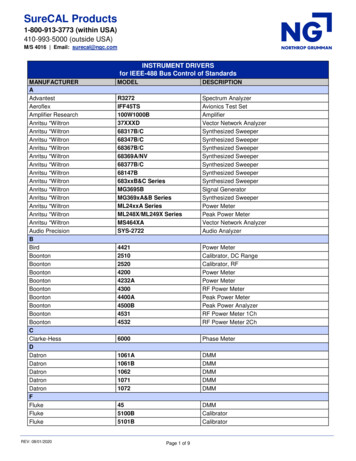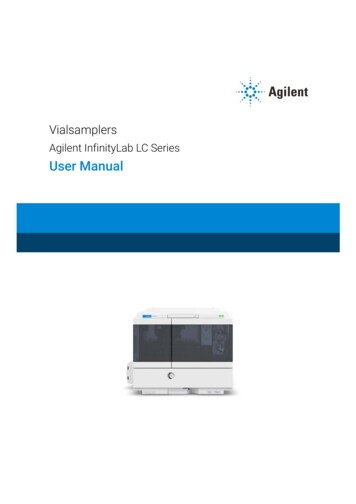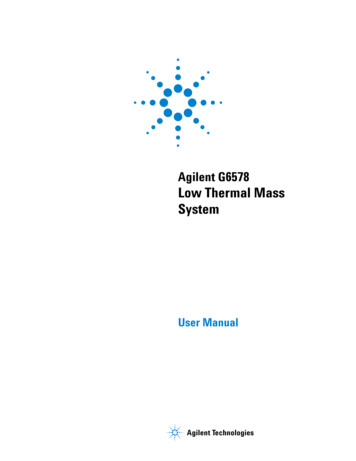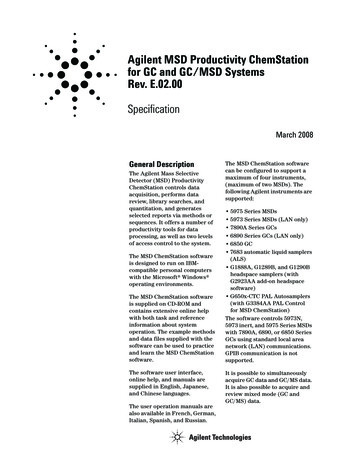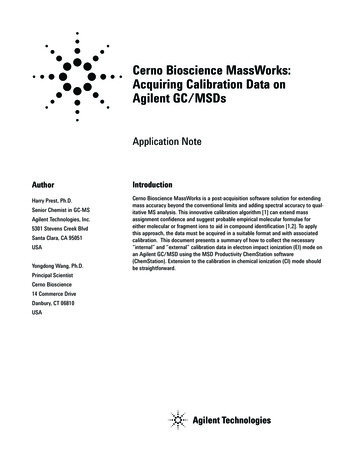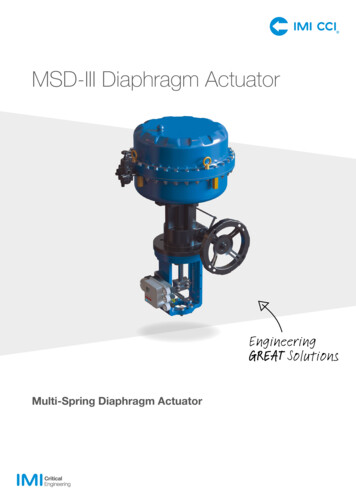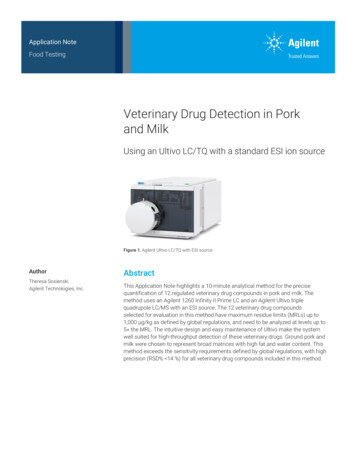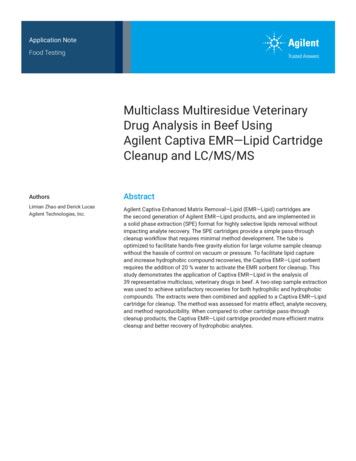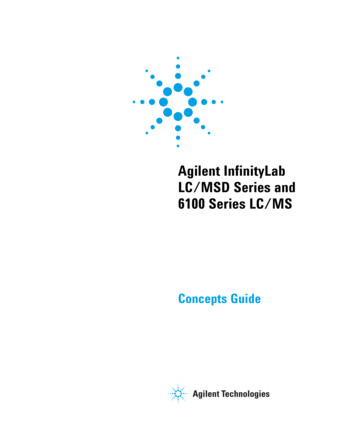
Transcription
Agilent InfinityLabLC/MSD Series and6100 Series LC/MSConcepts Guide
Notices Agilent Technologies, Inc. 2017WarrantyNo part of this manual may be reproducedin any form or by any means (includingelectronic storage and retrieval or translation into a foreign language) without prioragreement and written consent from Agilent Technologies, Inc. as governed byUnited States and international copyrightlaws.The material contained in this document is provided “as is,” and is subject to being changed, without notice,in future editions. Further, to the maximum extent permitted by applicablelaw, Agilent disclaims all warranties,either express or implied, with regardto this manual and any informationcontained herein, including but notlimited to the implied warranties ofmerchantability and fitness for a particular purpose. Agilent shall not beliable for errors or for incidental orconsequential damages in connectionwith the furnishing, use, or performance of this document or of anyinformation contained herein. ShouldAgilent and the user have a separatewritten agreement with warrantyterms covering the material in thisdocument that conflict with theseterms, the warranty terms in the separate agreement shall control.Manual Part NumberG1960-90104EditionRevision A, May 2017Agilent Technologies, Inc.5301 Stevens Creek Blvd.Santa Clara, CA 95051Software RevisionThis guide is valid for the C.01.07 SR3 orlater revision of the Agilent OpenLAB CDSChemStation Edition software for the InfinityLab LC/MSD Series and 6100 SeriesLC/MS until superseded.Technology LicensesThe hardware and/or software described inthis document are furnished under alicense and may be used or copied only inaccordance with the terms of such license.Restricted Rights LegendU.S. Government Restricted Rights. Software and technical data rights granted tothe federal government include only thoserights customarily provided to end user customers. Agilent provides this customarycommercial license in Software and technical data pursuant to FAR 12.211 (TechnicalData) and 12.212 (Computer Software) and,for the Department of Defense, DFARS252.227-7015 (Technical Data - CommercialItems) and DFARS 227.7202-3 (Rights inCommercial Computer Software or Computer Software Documentation).Safety NoticesCAUTIONA CAUTION notice denotes a hazard. It calls attention to an operating procedure, practice, or the likethat, if not correctly performed oradhered to, could result in damageto the product or loss of importantdata. Do not proceed beyond aCAUTION notice until the indicated conditions are fully understood and met.WAR NINGA WARNING notice denotes ahazard. It calls attention to anoperating procedure, practice, orthe like that, if not correctly performed or adhered to, could resultin personal injury or death. Do notproceed beyond a WARNINGnotice until the indicated conditions are fully understood andmet.Agilent InfinityLab LC/MSD Series and 6100 Series LC/MS Concepts
In This Guide.The Concepts Guide presents an overview of the InfinityLabLC/MSD Series and 6100 Series LC/MS mass selective detector,to help you understand how the hardware and software work.1Overview of Hardware and SoftwareLearn how the hardware works in the InfinityLab LC/MSDSeries and 6100 Series LC/MS instrument, and get a briefintroduction to the OpenLAB CDS ChemStation Editionprogram.2Instrument PreparationLearn the concepts you need to prepare the LC and column foran analysis, and to tune the MS.3Data AcquisitionLearn about setting up methods and running samples.4Data AnalysisLearn the concepts you need for qualitative and quantitativedata analysis with the ChemStation Edition program.5ReportsLearn about predefined results reports and about setting upcustom reports.6Verification of PerformanceLearn the concepts for Operational Qualification/ PerformanceVerification (OQ/PV) and system verification with theChemStation Edition program.7Maintenance and TroubleshootingLearn about tools that are proved in the ChemStation Editionprogram to help you maintain your system and diagnose and fixproblems.Agilent InfinityLab LC/MSD Series and 6100 Series LC/MS Concepts Guide3
This page intentionally left blank.4Agilent InfinityLab LC/MSD Series and 6100 Series LC/MS Concepts
Content1Overview of Hardware and Software9How the Agilent mass selective detectors workOverview10Details1110Types of data you can acquire 15Scan versus selected ion monitoring (SIM) 15Generation of fragment ions: low versus high fragmentorPositive versus negative ions 18Multiple signal acquisition 1916Ion sources21Electrospray ionization (ESI) 21Agilent Jet Stream25Atmospheric pressure chemical ionization (APCI) 27Atmospheric pressure photoionization (APPI) 29Multimode ionization (MMI) 30Introduction to the ChemStation Edition programOverview31Reviewing data remotely332Instrument Preparation3135Preparation of the LC system 36Purpose36Summary of procedures 36Setting parameters for LC modules 38Column conditioning and equilibration 39Monitoring the stability of flow and pressurePreparation of the MS – tuningOverview424142Agilent InfinityLab LC/MSD Series and 6100 Series LC/MS Concepts Guide5
ContentsWays to tune 44When to tune – Check TuneAutotune 47Manual tuning 49Tune reports 51Gain calibration 523Data Acquisition4555Working with methods56Method and Run Control View 56Loading, editing, saving and printing methodsMore on editing methods 5958Running samples 62Running a single sample63Running a sequence 64Flow injection analysis 67Monitoring analyses 70Online signal plots 70Logbooks 71Instrument shutdown 724Data Analysis73The Data Analysis View74Loading and manipulating chromatograms 76Loading signals 77Removing signals from the chromatogram displayChanging how chromatograms are displayed 81Working with spectraDisplaying spectraPeak purity 858384Performing quantification68186Agilent InfinityLab LC/MSD Series and 6100 Series LC/MS Concepts Guide
ContentsIntegrating peaksCalibration8886Data review and sequence reprocessingThe Navigation Table 90Batch review915Reports9093Using predefined reports 94Generating reports 94Report styles 95Defining custom reports 96Summary of process96Example report templates96The Report Layout View 976Verification of PerformanceThe Verification (OQ/PV) View99100Instrument verification101Setting up and running instrument verificationAvailable OQ/PV tests 104Verification logbook 105System verification106Overview106Setting up and running system verification7Maintenance and TroubleshootingThe Diagnosis ViewOverview110Instrument panelLogbooks 113Maintenance102107109110111114Agilent InfinityLab LC/MSD Series and 6100 Series LC/MS Concepts Guide7
ContentsEarly maintenance feedback 114Maintenance logbook 115Maintenance procedures 115Venting and pumping down the MS116Diagnosing and fixing problems 117Symptoms and causes 117Diagnostic tests for the MS 118Fixing problems1208Agilent InfinityLab LC/MSD Series and 6100 Series LC/MS Concepts Guide
InfinityLab LC/MSD Series and 6100 Series LC/MSConcepts Guide1Overview of Hardware and SoftwareHow the Agilent mass selective detectors work 10Overview 10Details 11Types of data you can acquire 15Scan versus selected ion monitoring (SIM) 15Generation of fragment ions: low versus high fragmentor 16Positive versus negative ions 18Multiple signal acquisition 19Ion sources 21Electrospray ionization (ESI) 21Atmospheric pressure chemical ionization (APCI) 27Atmospheric pressure photoionization (APPI) 29Multimode ionization (MMI) 30Introduction to the ChemStation Edition program 31Overview 31Reviewing data remotely 33This chapter provides an overview of the hardware andChemStation Edition program that comprises the InfinityLabLC/MSD Series and 6100 Series LC/MS systems. The InfinityLabLC/MSD Series consists of two models: LC/MSD XT andLC/MSD. The 6100 Series LC/MS family consists of threemodels: 6120B, 6130B, and 6150B.9
1Overview of Hardware and SoftwareHow the Agilent mass selective detectors workHow the Agilent mass selective detectors workOverviewMass selective detectors (MSD) analyze ions moving through avacuum to produce mass spectra. Mass spectra provide valuableinformation about the molecular weight, structure, identity,quantity, and purity of a sample. MSDs add specificity to bothqualitative and quantitative analyses.A quadrupole mass analyzer issometimes called a quadrupolemass filter or a quadrupole.Figure 1 shows a diagram of Agilent MSD instrument. Theionization of a sample occurs at atmospheric pressure in the ionsource that is shown on the left. The Agilent MSDs arecompatible with a number of Agilent atmospheric pressureionization (API) sources.HPLC inletnebulizercapillaryion opticsquadrupolemass filterdetectorionsourceroughpumpFigure 1API – atmospheric pressureionization10split-flowturbo pumpBlock diagram for an Agilent MSDA common atmospheric sampling interface introduces ionsfrom these ionization sources into the vacuum system of themass spectrometer. Various ion-optic elements focus and guidethe ions through a series of vacuum stages until they reach thequadrupole mass analyzer, which separates the ions. The ionsthen travel to the detector, where they are recorded as signals.Agilent InfinityLab LC/MSD Series and 6100 Series LC/MS Concepts Guide
Overview of Hardware and SoftwareDetails1DetailsFigure 2 and Figure 3 show more detailed schematics of the ionpaths in an Agilent MSD. After the API source forms ions, theion-optic elements in the ion transport and focusing region ofthe system direct the ions toward the quadrupole and thedetector. During transit, the ions move from atmosphericpressure (760 torr) at the source to a vacuum in the 10-6 torrrange at the quadrupole and detector.Vacuum stage:1HPLC inlet234skimmeroctopolenebulizer5X10-6 torrcapillarydetector3 torrfragmentationzone (CID)lensesIon sourceFigure 2quadrupoleIon transport and focusing regionIon path for LC/MSD, LC/MSD XT, 6130 and 6150Agilent InfinityLab LC/MSD Series and 6100 Series LC/MS Concepts Guide11
1Overview of Hardware and SoftwareDetailsVacuum stage:HPLC inlet1234skimmersoctopolenebulizer6 10-6 torrcapillarydetector2 torrfragmentationzone (CID)lensesIon sourceFigure 3quadrupoleIon transport and focusing regionIon path for 6120The ion transport and focusing region of the Agilent MSD isenclosed in a vacuum manifold. The function of the vacuumsystem is to evacuate regions of ion focusing and transport andkeep the quadrupole at low pressure.Because the nebulizer is at a right angle to the inlet capillary,most of the solvent is vented from the spray chamber and neverreaches the capillary. Only ions, drying gas, and a small amountof solvent are transmitted through the capillary.By autotuning the instrument, youautomatically set most of thevoltages for the elements in theion path. See “Preparation of theMS – tuning” on page 42.The following discussion of the ion optics is organized accordingto the stages of the ion path and the vacuum stages of the massspectrometer.Ion transport and fragmentation (first vacuum stage)Ions produced in the API source are electrostatically drawnthrough a drying gas and then through a heated samplingcapillary into the first stage of the vacuum system. Near the exitof the capillary is a metal skimmer with a small hole. Heavierions with greater momentum pass through the skimmer12Agilent InfinityLab LC/MSD Series and 6100 Series LC/MS Concepts Guide
Overview of Hardware and SoftwareDetails1aperture. Most of the lighter drying gas (nitrogen) molecules aredeflected by the skimmer and pumped away by a rough pump.The ions that pass through the skimmer move into the secondstage of the vacuum system.The atmospheric pressure ionization techniques are allrelatively “soft” techniques. They generate primarily: Molecular ions M or M Protonated molecules [M H] Simple adduct ions [M Na] Ions representing simple losses, such as the loss of a watermolecule [M H - H2O] CID – collision-induceddissociationThese types of ions give molecular weight information, but youoften need complementary structural information. To gainstructural information, you can fragment the analyte ions in thefirst vacuum stage. To do that, you give them extra energy andcollide them with neutral molecules in a process known ascollision-induced dissociation (CID). A voltage is applied at theend of the atmospheric sampling capillary to add energy to thecollisions and create more fragmentation. For moreinformation, see “Generation of fragment ions: low versus highfragmentor” on page 16.Ion transport (second and third vacuum stages)An octopole ion guide is a set ofsmall parallel metal rods with acommon open axis through whichthe ions can pass.LC/MSD, LC/MSD XT, 6130 and 6150 In the second vacuumstage, the ions are immediately focused by an octopole ion guidethat traverses two vacuum stages. The ions pass through theoctopole ion guide because of the momentum they receivedfrom being drawn from atmospheric pressure through thesampling capillary. Radio-frequency voltage applied to theoctopole rods repels ions above a particular mass range to theopen center of the rod set. The ions exit this ion guide and thenpass through two focusing lenses into the fourth stage of thevacuum system.Agilent InfinityLab LC/MSD Series and 6100 Series LC/MS Concepts Guide13
1Overview of Hardware and SoftwareDetails6120 In the second vacuum stage, the ions are transportedbetween skimmer 1 and skimmer 2. They then enter the thirdvacuum stage, where they pass through the octopole ion guide.The ions exit this ion guide and then pass through two focusinglenses into the fourth stage of the vacuum system.Ion separation and detection (fourth vacuum stage)In the fourth vacuum stage, the quadrupole mass analyzerseparates the ions by mass-to-charge ratio. An electronmultiplier then detects the ions.m/z – mass/charge ratioThe quadrupole mass analyzer (Figure 4) consists of fourparallel rods to which specific direct-current (DC) andradio-frequency (RF) voltages are applied. The analyte ions aredirected down the center of the rods. Voltages applied to therods generate electromagnetic fields. These fields determinewhich mass-to-charge ratio of ions can pass through the filter ata given time. The ions that pass through are focused on thedetector.To detectorFrom ionsourceFigure 414Quadrupole mass analyzerAgilent InfinityLab LC/MSD Series and 6100 Series LC/MS Concepts Guide
Overview of Hardware and SoftwareTypes of data you can acquire1Types of data you can acquireScan versus selected ion monitoring (SIM)As shown in Figure 5, quadrupole mass analyzers can operatein two modes. To get the most from your analysis, it isimportant to pick the appropriate mode. The discussion belowwill help you choose.1 scanm/zscanabundanceYou set up a scan or SIM analysisin the Method and Run Controlview, described in Chapter 3.m/ztime1 scanabundancediscrete massesm/zSIMtimeFigure 5mass rangem/zA quadrupole mass analyzer can operate in either scan modeor selected ion monitoring (SIM) modeScan modeIn scan mode, a range of m/z values are analyzed, for example,m/z 200 to 1000. The quadrupole sequentially filters one massafter another, with an entire scan typically taking about asecond. (The exact time depends on mass range and scanspeed.) The MS firmware steps the quadrupole throughincreasing DC and RF voltages, which sequentially filters thecorresponding m/z values across a mass spectrum.Agilent InfinityLab LC/MSD Series and 6100 Series LC/MS Concepts Guide15
1Overview of Hardware and SoftwareGeneration of fragment ions: low versus high fragmentorA full scan analysis is useful because it shows all of the ions in agiven mass range that are present in the ion source. Because itprovides a complete picture of all the ionized compounds thatoccur above the detection limit in the chosen mass range, a fullscan analysis is often used for sample characterization,structural elucidation, and impurity analysis. It is also thestarting point for development of methods for SIM dataacquisition (discussed next).Selected ion monitoring (SIM) modeTo obtain the best sensitivity, the quadrupole is operated in SIMmode. In SIM mode, the quadrupole analyzes the signals of onlya few specific m/z values. The required RF/DC voltages are setto filter one mass at a time. Rather than stepping through all them/z values in a given mass range, the quadrupole steps onlyamong the values that the analyst chooses. Because thequadrupole spends more time sampling each of these chosenm/z values, the system can detect lower levels of sample.SIM mode is significantly more sensitive than scan mode butprovides information about fewer ions. Scan mode is typicallyused for qualitative analyses or for quantitation when analytemasses are not known in advance. SIM mode is used forquantitation and monitoring of target compounds.Generation of fragment ions: low versus high fragmentorWhen you set up a method fordata acquisition, you can controlthe amount of fragmentation withthe fragmentor setting. You set upa method in the Method and RunControl view, described inChapter 3.Fragment ions, also known as product ions, are formed bybreaking apart precursor ions. On the InfinityLab LC/MSDSeries and 6100 Series LC/MS instruments, the fragmentationregion is between the capillary exit and the skimmer, where thegas pressure is about 2 to 3 torr. Depending on the voltage inthis region, precursor ions may pass through unchanged or theymay be fragmented.When a lower voltage is applied across this region, the ions passthrough unchanged. Even if these ions collide with the gasmolecules in this region, they usually do not have enoughenergy to fragment. (See Figure 6.)16Agilent InfinityLab LC/MSD Series and 6100 Series LC/MS Concepts Guide
1279.1Overview of Hardware and SoftwareGeneration of fragment ions: low versus high fragmentorCH3350000O300000S [M H]ONNHNCH3250000H2N200000281.0 280.010000050000301.0150000 [M Na]0100m/z300Mass spectrum of sulfamethazine – low fragmentorm/z156124.1Figure 6200CH3m/z186OO S186.080000279.1156.1CH3m/z213m/z124 323.0[M Na]280.1213.2187.0157.1125.1107.120000NH2N[M H]301.040000 NHm/z108108.260000N0100Figure 7200300m/zMass spectrum of sulfamethazine – high fragmentorAgilent InfinityLab LC/MSD Series and 6100 Series LC/MS Concepts Guide17
1Overview of Hardware and SoftwarePositive versus negative ionsIf the voltage is increased, the ions have more translationalenergy. Then if the ions collide with gas molecules, thecollisions convert the translational energy into molecularvibrations that can cause the ions to fragment. This is calledcollision-induced dissociation (CID). Figure 7 shows anexample. Even though this fragmentation does not occur wherethe ions are formed at atmospheric pressure, it is a tradition tocall this type of fragmentation “in-source CID.” The ions frommolecular fragments are used for structural determination orconfirmation of the presence of a particular chemical species.It is possible to produce both molecular ions and fragment ionswithin the same spectrum by using an intermediatefragmentation voltage.FIA – flow injection analysisThe ideal fragmentation voltage depends on the structure of thecompound and the needs of the analysis. For target compoundanalysis, it is good practice to determine in advance thecompound’s response to fragmentor setting. The fastest way toaccomplish this is with a flow injection analysis (FIA) series. AnFIA series allows you to inject the compound multiple timeswithin the same run, and to vary the fragmentor setting indifferent time windows. From the resulting data, you can judgethe best fragmentor setting. For more information on FIA, see“Flow injection analysis” on page 67.Positive versus negative ionsYou set the ion polarity when youset up a method in the Method andRun Control view, described inChapter 3.Atmospheric pressure ionization techniques can produce bothpositive and negative ions. For any given analysis, thepredominant ion type depends on the chemical structure of theanalyte and (particularly for electrospray ionization) the pH ofthe solution. While either or both ion types may be present inthe ion source, the polarity of the ion optics in the ion transportand focusing region determines which ion type is detected.Analyses of positive and negative ions require different settingsfor the ion optics. The software-controlled autotune processoptimizes the settings for both positive and negative ions, and18Agilent InfinityLab LC/MSD Series and 6100 Series LC/MS Concepts Guide
Overview of Hardware and SoftwareMultiple signal acquisition1stores them in a single tune file. During data acquisition, theChemStation Edition program accesses the tune file for theappropriate settings.Multiple signal acquisitionYou establish the conditions formultiple signal acquisition in theMethod and Run Control view,described in Chapter 3.The InfinityLab LC/MSD Series and 6100 Series LC/MS modelsallow you to acquire multiple types of data during a singleanalysis. Within a single analytical run, you can choosealternating positive and negative ionization; alternating highand low fragmentor settings; and alternating scan and SIMmodes. Because optimum MS conditions vary from compoundto compound, this multisignal capability enables you to analyzemore compounds, with greater sensitivity, within a single run.Polarity switchingThe InfinityLab LC/MSD Series and 6100 Series LC/MS modelsallow you to switch from scan to scan between analysis ofpositive ions and analysis of negative ions. To switch polaritiesvery quickly, these models incorporate fast-switching powersupplies for the API source, the lens system, the quadrupole,and the detector. The ability to switch polarities on thechromatographic time scale is very useful for analysis ofcomplete unknowns because it obviates the need to run thesample twice to detect both types of ions.Alternating high/low fragmentorWith the InfinityLab LC/MSD Series and 6100 Series LC/MSmodels, you can also alternate from scan to scan between highand low fragmentation voltages. This capability allows you toacquire scans at low fragmentor settings for molecular weightinformation, and high fragmentor settings for structuralinformation.Agilent InfinityLab LC/MSD Series and 6100 Series LC/MS Concepts Guide19
1Overview of Hardware and SoftwareMultiple signal acquisitionAlternating SIM/scanMany analyses require use of SIM mode to monitor and/orquantitate target compounds at very low levels. Sometimes it isalso desirable to characterize the other sample componentswith a scan analysis. The InfinityLab LC/MSD Series and 6100Series LC/MS models allow you to alternate between SIM andscan modes, so you can accomplish both goals in a singleanalysis.Putting it all togetherThe InfinityLab LC/MSD Series and 6100 Series LC/MS cancycle through four different user-selected acquisition modes ona scan-by-scan basis within a single run. For example, you canset up a single run to do the following: Positive ion scan with low fragmentor voltage Positive ion scan with high fragmentor voltage Negative ion scan with low fragmentor voltage Negative ion scan with high fragmentor voltageSuch an analysis is ideal for a mixture of compounds wheresome respond better in positive mode and some respond betterin negative mode, and where you need both molecular ions andfragment ions.The time required for one cycle varies depending on the numberof modes chosen, the scan range, and the interscan delayrequired for the switching. For separations with narrowchromatographic peaks, it is important to ensure that totalcycle time is short enough that the instrument makes sufficientmeasurements across the peak.The system issues a warning message when parameter settingsresult in a cycle time that is longer than recommended foroptimum performance. You can fix the problem by selectingFast Scan or Ultrafast scan or by increasing the Peakwidth.20Agilent InfinityLab LC/MSD Series and 6100 Series LC/MS Concepts Guide
Overview of Hardware and SoftwareIon sources1Ion sourcesThe InfinityLab LC/MSD Series and 6100 Series LC/MSinstruments operate with the following interchangeableatmospheric pressure ionization (API) sources: ESI (electrospray ionization) Agilent Jet Stream (LC/MSD XT, 6130 and 6150 only) APCI (atmospheric pressure chemical ionization) APPI (atmospheric pressure photoionization) MMI (multimode ionization)N O TEThe sources that are used on the InfinityLab LC/MSD Series and 6100Series LC/MS systems are the B-type sources. The InfinityLab LC/MSDSeries and 6100 Series LC/MS systems are not compatible with theA-type sources that were used on previous Agilent LC/MS models.Electrospray ionization (ESI)You control the spray chamberparameters (nebulizer pressure,drying gas flow and temperature,and capillary voltage) when youset up a method in the Method andRun Control view, described inChapter 3.Electrospray ionization relies in part on chemistry to generateanalyte ions in solution before the analyte reaches the massspectrometer. As shown in Figure 8, the LC eluent is sprayed(nebulized) into a spray chamber at atmospheric pressure in thepresence of a strong electrostatic field and heated drying gas.The electrostatic field occurs between the nebulizer, which is atground in the Agilent design, and the capillary, which is at highvoltage.The spray occurs at right angles to the capillary. This patentedAgilent design reduces background noise from droplets,increases sensitivity, and keeps the capillary cleaner for alonger period of time.Agilent InfinityLab LC/MSD Series and 6100 Series LC/MS Concepts Guide21
1Overview of Hardware and SoftwareElectrospray ionization (ESI)HPLC inletnebulizercapillarysolventsprayheated drying gasFigure 8Electrospray ion sourceElectrospray ionization (ESI) consists of four steps:1 Formation of ions2 Nebulization3 Desolvation4 Ion evaporationFormation of ionsIon formation in API-electrospray occurs through more thanone mechanism. If the chemistry of analyte, solvents, andbuffers is correct, ions are generated in solution beforenebulization. This results in high analyte ion concentration andgood API-electrospray sensitivity.22Agilent InfinityLab LC/MSD Series and 6100 Series LC/MS Concepts Guide
Overview of Hardware and SoftwareElectrospray ionization (ESI)1Preformed ions are not always required for ESI. Somecompounds that do not ionize in solution can still be analyzed.The process of nebulization, desolvation, and ion evaporationcreates a strong electrical charge on the surface of the spraydroplets. This can induce ionization in analyte molecules at thesurface of the droplets.NebulizationNebulization (aerosol generation) takes the sample solutionthrough these steps:a Sample solution enters the spray chamber through agrounded needle called a nebulizer.b For high-flow electrospray, nebulizing gas enters the spraychamber concentrically through a tube that surrounds theneedle.c The combination of strong shear forces generated by thenebulizing gas and the strong voltage (2–6 kV) in the spraychamber draws out the sample solution and breaks it intodroplets.d As the droplets disperse, ions of one polaritypreferentially migrate to the droplet surface due toelectrostatic forces.e As a result, the sample is simultaneously charged anddispersed into a fine spray of charged droplets, hence thename electrospray.Because the sample solution is not heated when the aerosol iscreated, ESI does not thermally decompose most analytes.Desolvation and ion evaporationBefore the ions can be mass analyzed, solvent must be removedto yield a bare ion.A counter-current of neutral, heated drying gas, typicallynitrogen, evaporates the solvent, decreasing the dropletdiameter and forcing the predominantly like surface-chargescloser together (see Figure 9).Agilent InfinityLab LC/MSD Series and 6100 Series LC/MS Concepts Guide23
1Overview of Hardware and SoftwareElectrospray ionization (ESI)evaporation -- - - - - Figure 9Coulomb repulsion – repulsionbetween charged species of thesame signanalyte ion ejected -- - - - - - -- --- - - - - Desorption of ions from solutionWhen the force of the Coulomb repulsion equals that of thesurface tension of the droplet, the droplet explodes, producingsmaller charged droplets that are subject to furtherevaporation. This process repeats itself, and droplets with ahigh density of surface-charges are formed. When chargedensity reaches approximately 108 V/cm3, ion evaporationoccurs (direct ejection of bare ions from the droplet surface).These ions are attracted to and pass through a capillarysampling orifice into the ion optics and mass analyzer.The importance of solution chemistryThe choice of solvents and buffers is a key to successfulionization with electrospray. Solvents like methanol that havelower heat capacity, surface tension, and dielectric constant,promote nebulization and desolvation. For best results inelectrospray mode: Adjust solvent pH according to the polarity of ions desiredand the pH of the sample. To enhance ion desorption, use solvents that have low heatsof vaporization and low surface tensions. Select solvents that do not neutralize ions through gas-phasereactions such as proton transfer or ion pair reactions. To reduce the buildup of salts in the ion source, select morevolatile buffers.24Agilent InfinityLab LC/MSD Series and 6100 Series LC/MS Concepts Guide
Overview of Hardware and SoftwareAgilent Jet Stream1Multiple chargingElectrospray is especially useful for analyzing largebiomolecules such as proteins, peptides, and oligonucleotides,but can also analyze smaller molecules like drugs andenvironmental contaminants. Large molecules often acquiremore than one charge. Because of this multiple charging, youcan use electrospray to analyze molecules as large as 150,000 ueven though the mass range (or more accurately mass-to-chargerange) for a typical q
Contents Agilent InfinityLab LC/MSD Series and 6100 Series LC/MS Concepts Guide 7 Integrating peaks 86 Calibration 88 Data review and sequence reprocessing 90

